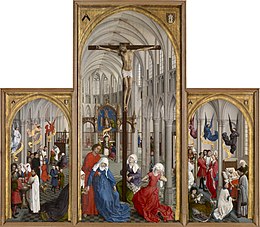සක්රමේන්තුව

| A series of articles on |
| Grace in Christianity |
|---|
|
|
| මෙම ලිපිය |
| කිතු දහම පිළිබඳ ලිපි මාලාවක කොටසකි |
|---|
 |
'සක්රමේන්තුව යනු ක්රිස්තියානි චාරිත්රයකි, එය විශේෂ හා වැදගත් ලෙස පිළිගැනේ.[1] එවැනි චාරිත්රවල පැවැත්ම හා අර්ථය පිළිබඳව විවිධ මත පවතී. බොහෝ කිතුනුවන් සක්රමේන්තු දෙවියන්ගේ යථාර්ථයේ දෘශ්ය සංකේතයක් මෙන්ම දෙවියන් වහන්සේගේ කරුණාව සඳහා වූ නාලිකාවක් ලෙස සලකති. කතෝලික, ලූතරන්, ඇංග්ලිකන්, මෙතෝදිස්ත සහ ප්රතිසංස්කරණය ඇතුළු බොහෝ ක්රිස්තියානි නිකායන්, හිපෝහි ඔගස්ටින් විසින් සකස් කරන ලද සක්රමේන්තුව පිළිබඳ නිර්වචනය පිළිගනී: එය යේසුස් ක්රිස්තුස් විසින් ආරම්භ කරන ලද අභ්යන්තර කරුණාවේ බාහිර ලකුණකි.[2][3][4][5] සක්රමේන්තු මගින් දෙවියන් වහන්සේගේ වරප්රසාදය පෙන්නුම් කරන්නේ සහභාගිවන්නාට බාහිරව නිරීක්ෂණය කළ හැකි ආකාරයටය.[5]
කතෝලික සභාව, හුසයිට් සභාව සහ පැරණි කතෝලික සභාව සක්රමේන්තු හතක් හඳුනා ගනී: බව්තීස්මය, පසුතැවිලි වීමේ සක්රමේන්තුව (සංහිඳියාව හෝ පාපොච්චාරණය), දිව්ය සත්ප්රසාදය (හෝ ශුද්ධ වූ හවුල), අභිවෘද්ධි ආලේපය, ආශිර්වාදකාර බන්දනය (විවාහය), පූජාත්වරය සහ රෝගීන්ගේ ආලේපය.[6][7] නැගෙනහිර ඕතඩොක්ස් පල්ලිය සහ පෙරදිග ඕතඩොක්ස් පල්ලිය මෙන්ම නැගෙනහිර කතෝලික පල්ලි වැනි පෙරදිග පල්ලි ද ප්රධාන සක්රමේන්තු හතක් ඇති බව විශ්වාස කරති. ඔවුන් μυστήριον (අභිරහස්) යන ග්රීක වචනයට අනුරූප වන පරිශුද්ධ අභිරහස් යන වචන භාවිතා කරන අතර බටහිර සම්ප්රදායේ සක්රමේන්තු ලෙස හඳුන්වන චාරිත්රවලට සහ පල්ලිය වැනි වෙනත් යථාර්ථයන්ට ද එය යොදා ගනී.[8][9][10] ප්රතිසංස්කරණ සම්ප්රදාය තුළ ඇති බොහෝ රෙපරමාදු නිකායන්, ක්රිස්තුස් වහන්සේ විසින් පිහිටුවන ලද සක්රමේන්තු දෙකක්, දිව්ය සත්ප්රසාදය (හෝ ශුද්ධ වූ හවුල) සහ බව්තීස්මය හඳුනා ගනී.[11] ලුතරන් සක්රමේන්තුවලට මෙම දෙක ඇතුළත් වන අතර, බොහෝ විට තුන්වන සක්රමේන්තුව ලෙස පාපොච්චාරණය (සහ නිරවුල් කිරීම) එකතු කරයි.[11][12] ඇංග්ලිකන් සහ මෙතෝදිස්ත ඉගැන්වීම නම් "ශුභාරංචියේ අපගේ ස්වාමීන් වන ක්රිස්තුස් වහන්සේ විසින් පත් කරන ලද සක්රමේන්තු දෙකක් තිබේ, එනම් බව්තීස්මය සහ ස්වාමීන්ගේ රාත්රී භෝජනය" සහ "සාක්රමේන්තු ලෙස පොදුවේ හඳුන්වන එම පහ, එනම් තහවුරු කිරීම, පසුතැවිලි වීම, නියෝග, විවාහය සහ අතිශයින් වෙන්වීම, ශුභාරංචියේ සක්රමේන්තු සඳහා ගණන් නොගත යුතුය."[13][14]
ක්වේකරිසම් වැනි සමහර සම්ප්රදායන් කිසිදු චාරිත්රයක් පිළිපදින්නේ නැත, නැතහොත් ඇනබැප්ටිස්ට්වරුන් සම්බන්ධයෙන් ගත් කල, ඒවා හුදෙක් මතක් කිරීම් හෝ ප්රශංසනීය පිළිවෙත් වන අතර ඒවා සත්ය අනුග්රහය ලබා නොදෙන නමුත් සක්රමේන්තු නොව "ආඥාපනත" වේ.[15]
සටහන්
[සංස්කරණය]මූලාශ්ර
[සංස්කරණය]- ^ Stice, Randy (2017-11-21). Understanding the Sacraments of Initiation: A Rite-Based Approach (ඉංග්රීසි බසින්). LiturgyTrainingPublications. p. 41. ISBN 9781618331847.
- ^ The Junior Catechism of the Methodist Episcopal Church and the Methodist Episcopal Church, South (ඉංග්රීසි බසින්). Jennings and Graham. 1905. p. 26.
87. What is a sacrament? A sacrament is an outward sign, appointed by Christ, of an inward grace. (Rom. 4:11.)
- ^ Lutheran Forum, Volumes 38–39 (ඉංග්රීසි බසින්). 2004. p. 46.
A sacrament is an outward sign of an inward grace.
- ^ Lyden, John C.; Mazur, Eric Michael (27 March 2015). The Routledge Companion to Religion and Popular Culture (ඉංග්රීසි බසින්). Routledge. p. 180. ISBN 9781317531067.
Augustine defines a sacrament as "an outward sign of an inward grace". Reformed tradition subscribes to this definition (see McKim 2001: 135).
- ^ a b "Catechism of the Catholic Church, 1131". www.vatican.va. සම්ප්රවේශය 2020-01-04.
- ^ Journal of the Moscow Patriarchate (ඉංග්රීසි බසින්). Patriarch of Moscow and all Rus'. 1977. p. 67.
The Czechoslovak Hussite Church professes Seven Sacraments.
- ^ Melton, J. Gordon; Baumann, Martin (21 September 2010). Religions of the World: A Comprehensive Encyclopedia of Beliefs and Practices, 2nd Edition (ඉංග්රීසි බසින්). ABC-CLIO. p. 2137. ISBN 9781598842043.
The Old Catholic Church accepts seven sacraments, the intermediaries of salvation.
- ^ "Understanding the Sacraments of the Orthodox Church - Introduction to Orthodoxy Articles - Greek Orthodox Archdiocese of America". www.goarch.org (ඇමෙරිකානු ඉංග්රීසි බසින්). සම්ප්රවේශය 2020-01-04.
- ^ "Holy Trinity Church" (ඇමෙරිකානු ඉංග්රීසි බසින්). සම්ප්රවේශය 2020-01-04.
- ^ Sacramental Rites in the Coptic Orthodox Church. Copticchurch.net. 4 August 2016.
- ^ a b Haffner, Paul (1999). The Sacramental Mystery (ඉංග්රීසි බසින්). Gracewing Publishing. p. 11. ISBN 9780852444764.
The Augsburg Confession drawn up by Melanchton, one of Luther's disciples admitted only three sacraments, Baptist, the Lord's Supper and Penance. Melanchton left the way open for the other five sacred signs to be considered as "secondary sacraments". However, Zwingli, Calvin and most of the later Reformed tradition accepted only Baptism and the Lord's Supper as sacraments, but in a highly symbolic sense.
- ^ Smith, Preserved (1911). The Life and Letters of Martin Luther. Houghton Mifflin. p. 89.
In the first place I deny that the sacraments are seven in number, and assert that there are only three, baptism, penance, and the Lord's Supper, and that all these three have been bound by the Roman Curia in a miserable captivity and that the Church has been deprived of all her freedom.
- ^ Thirty-Nine Articles, Article XXV
- ^ Articles of Religion (Methodist), Article XVI
- ^ Jeffrey Gros, Thomas F. Best, Lorelei F. Fuchs (editors), Growth in Agreement III: International Dialogue Texts and Agreed Statements, 1998–2005 (Eerdmans 2008 ISBN 978-0-8028-6229-7), p. 352
ආශ්රිත ලිපි
[සංස්කරණය]භාහිර සබැඳි
[සංස්කරණය]
 Kennedy, Daniel Joseph (1912). "Sacraments". Catholic Encyclopedia. 13. New York: Robert Appleton Company.
Kennedy, Daniel Joseph (1912). "Sacraments". Catholic Encyclopedia. 13. New York: Robert Appleton Company.- Exploring the Sacraments in Anglican Ministry
- The Sacraments in the Orthodox Church
